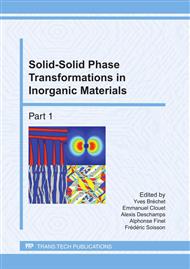[1]
B. Predel, in: Phase Equilibria, Crystallographic and Thermodynamic Data of Binary Alloys Cr-Cs .. Cu-Zr, edited by O. Madelung, volume 5d of Landolt-Börnstein Numerical Data and Functional Relationships in Science and Technology, New Series, Group IV: Macroscopic Properties of Matter, Springer-Verlag Berlin Heidelberg (1994).
DOI: 10.1007/978-3-540-44756-6_169
Google Scholar
[2]
A. Wurtz: Compt. Rend. Vol. 18 (1844), p.702.
Google Scholar
[3]
J. A. Goedkoop and A.F. Andersen: Acta Cryst. Vol. 8 (1955), p.118.
Google Scholar
[4]
R. Burtovyy, E. Utzig, and M. Tkacz: Thermochimica Acta Vol. 363 (2000), p.157.
DOI: 10.1016/s0040-6031(00)00594-3
Google Scholar
[5]
R. Burtovyy, D. Włosewicz, A. Czopnik, and M. Tkacz: Thermochimica Acta Vol. 400 (2003), p.121–129.
DOI: 10.1016/s0040-6031(02)00489-6
Google Scholar
[6]
N. P. Fitzsimons, W. Jones, and P. J. Herley: Catalysis Letters Vol. 15 (1992), pp.83-94.
Google Scholar
[7]
H. J. Smithson, D. Morgan, A. Van der Ven, C. Marianetti, A. Pedith and G. Ceder: Mat. Res. Soc. Symp. Proc. Vol. 730 (MRS, Warrendale, PA, USA, 2002), p. V2. 2. 1.
DOI: 10.1557/proc-730-v2.2
Google Scholar
[8]
H. J. Smithson, C. Marianetti, D. Morgan, A. Van der Ven, A. Pedith and G. Ceder: Rhys. Rev. B Vol. 66 (2002), art. no. 144107.
Google Scholar
[9]
I. Puigdomenech and C. Taxén: Thermodynamic data for copper: Implications for the corrosion of copper under repository conditions, Technical Report TR-00-13, Swedish. Nucl. Fuel Waste Manag. Co., Stockholm (2000).
Google Scholar
[10]
F. Fischer: Z. Elektrochem. (Germany) Vol. 9 (1903), p.507.
Google Scholar
[11]
D. Miller: J. Phys. Chem. Vol. 13 (1909), p.256.
Google Scholar
[12]
H. W. Gillett: J. Phys. Chem. Vol. 13 (1909), p.332.
Google Scholar
[13]
K. J. Cheng: Anal. Chem. Vol. 27(7) (1955), p.1165.
Google Scholar
[14]
E. Protopopoff and P. Markus: Electrochim. Acta Vol. 51 (2005), p.408.
Google Scholar
[15]
S. Baroni, S. de Gironcoli, A. Dal Corso, and P. Gianozzi: Rev. Mod. Phys. Vol. 73 (2001), p.515.
Google Scholar
[16]
D. Vanderbilt: Phys. Rev. B Vol. 41 (1990), p.7892.
Google Scholar
[17]
J. P. Perdew, K. Burke, and M. Ernzerhof: Phys. Rev. Lett. Vol. 77 (1996), p.3865.
Google Scholar
[18]
Giannozzi P, Baroni S, Bonini N, et al.: J. Phys.: Cond. Matter Vol. 21 (2009), art. no. 395502; information on http: /www. quantum-espresso. org.
Google Scholar
[19]
P.A. Korzhavyi and B. Johansson: Thermodynamic properties of copper compounds with oxygen and hydrogen from first principles, Technical Report TR-10-30, Swedish. Nucl. Fuel Waste Manag. Co., Stockholm, (2010).
Google Scholar
[20]
W. Schäfer and A. Kirfel: Appl. Phys. A Vol. 74 (2002), p. S1010.
Google Scholar
[21]
R. Mittal, S. L. Chaplot, S. K. Mishra, and P. P. Bose: Phys. Rev. B Vol. 75 (2007), art. no. 174303.
Google Scholar
[22]
M. M. Beg and S. M. Shapiro: Phys. Rev. B Vol. 13 (1976), p.1728.
Google Scholar
[23]
P. Y. Yu and Y. R. Shen: Phys. Rev. B Vol. 12 (1975), p.1377.
Google Scholar
[24]
L. O. Werme and P. A. Korzhavyi: Catalysis Letters Vol. 135 (2010), p.165.
Google Scholar


